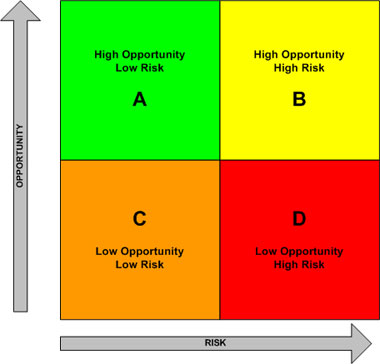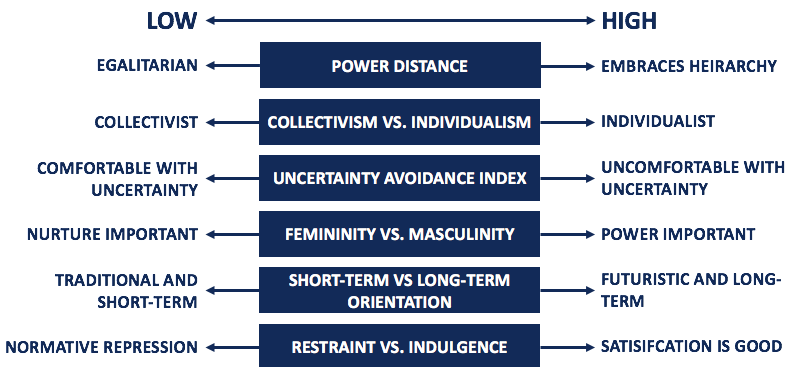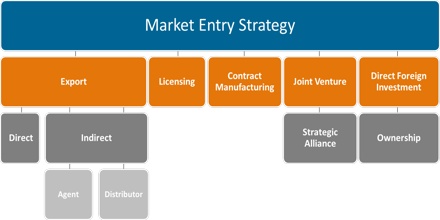Introduction
This section will detail the background information, including details about Sunvisionnair, its plans to expand to the market in South Africa, and its potential entry strategy. The solar energy market is increasing as more governments introduce their strategy for sustainable energy use instead of relying on fossil fuels and nuclear power. Sunvisionaire is a leading solar PV manufacturing company operating in India for approximately 10 years.
Similarly, possessing an automatic and robust manufacturing line based on German and Japanese technology ensures Sunvisionaire follows and utilizes safety practices, best quality, and environment conservation practices at their manufacturing level. Sunvisionaire possesses an internal quality team whose main focus is ensuring continuous quality through holding regular deliberations meetings.
Advice on Country of Entry

Figure 1 above shows the standard opportunity and risk matrix, where markets with the best potential in terms of profits and growth have the highest risks associated with the entry. Considering this, choosing a developing state in sub-Saharan-Arica where the demand for energy solutions is high, including sufficient consumer disposable income, is the best option for Sunvisionnair.
South Africa is a promising market for Sunvisionair as the state is actively developing, and its government supports the use of green energy. For example, Winning (2021) states that the local government plans to hold three rounds for the potential suppliers of green energy products in 2021. Since the government of South Africa is supportive of green energy development, one can assume that there will be more policies and purchase rounds for green energy products in this state. Hence, the political and legal environments of this state are beneficial for Sunnvisionnir’s entrance.
From the technological perspective, South Africa is the region’s most industrialized nation (Winning, 2021). This also supports this destination as a choice for Sunvisionaire since underdeveloped African countries consume little energy, even when examining the one derived from fossil fuels (Winning, 2021). Hence, choosing other states in the African region would not provide Sunvisionnair with a sufficient number of potential customers needed to support this business.
In comparison to Zimbabwe, South Africa is a better option because the latter state is more developed and has more potential for solar energy development. According to Moyo (2019), Zimbabwe is experiencing an energy crisis, and the government has to regulate the amounts of power provided to the citizens. Hence, it is administered during certain hours of the day, which suggests that the internal infrastructure of this state is not developed enough for solar energy.
Under Porter’s Diamond strategy, South Africa is a more favorable choice since it has the advantage of the government’s support for renewable industry. From a technological perspective, the states differ since Zimbabwe has a limited supply of energy resources, which inevitably impacts manufacturing and other industries (Moyo, 2019). Hence, demand conditions and factor conditions are better if South Africa is selected.
South Africa is a developing state with a potential for economic growth, which will help Sunvisionair gain more profits. Gross Domestic Product (GDP) of South Africa provides a suitable geographic location for Sunvisionaire. As established in 2019, South Africa’s GDP stood at around $730.913 billion (Explore all countries – South Africa, 2021). GDP assists in determining and reflecting on South Africa’s purchasing power. Therefore, a high GDP reflects more South Africans purchasing Solar PV products from Sunvisionaire. This implies, the majority of South African are likely to provide a proper market for Sunvisionaire products. Therefore, solar PV from Sunvisionaire is likely to acquire markets from South Africa.
Advice on Cultural and Institutional Differences
Sunvisionaire needs to utilize Hofstede’s frameworks to understand cultural, psychological differences between India and South Africa. Cultural distance has an effect on customers’ underlying behavior on Sunvisionaire management and marketing strategies. This creates corporate and national culture leaving Sunvisionaire with an option to invest or not. This cultural difference may occur to Sunvisionaire if it utilizes an entry strategy of buying a local company (Beugelsdijk, Kostova, and Roth, 2016). Therefore, Sunvisionaire needs to utilize greenfield as an entry strategy. The production of solar panels is labor and capital intensive.
Hence, under the Heckscher-Ohlin model, Sunvisionaire should export this product instead of establishing a manufacturing plant in the destination state. Under the Integration Responsiveness Framework, Sunivisionair should adopt the transnational strategy to retain high levels of local responsiveness. This is necessary to maintain a good focus both on the local African market, which differs culturally and socially from that of India, and maintaining a sufficient integration with Sunvisionair’s global strategy.
Sunvisionaire survival is dependent on power/ distance index. Ability of South Africans to measure how possession of employees’ power in Sunvisionaire is outlined. Realization of unequally distribution will create a problem to Sunvisionaire’s entry strategy (Beugelsdijk, Kostova, and Roth, 2016). A higher PDI is an indication of unequal power difference (Criminna et al., 2016). In this case, Sunvisionaire will be required to merge with a local company based in South Africa.
Additionally, a society possessing a power distance will be associated with a managerial style which is participative, decentralized levels of authority, the supervisory style will include a fewer staff, the organizational structure is flat, Sunvisionaire is conscious of employees’ rights, and authority is liable to questioning (Daniels, Radebaugh, and Sullivan, 2018). Higher power distance model by Sunvisionaire company will boost association between its employees within different organizational ranks.
Similarly, uncertainty avoidance dimension is key in determining Sunvisionaire’s success or failure in South Africa. Uncertainty avoidance index partakes two types of scores: high and low (Daniels, Radebaugh, and Sullivan, 2018). A low score implies maintaining a relaxed mood requiring practice rather than principles, unlike higher alternatives, which stick to codes considered rigid and intolerant to beliefs, behaviors, and ideas (Ciriminna et al., 2016). Therefore, societies exhibiting lower uncertainty avoidance index tend to believe there is no need for more rules than relevantly necessary already put in place.
Figure 1 shows the basic elements of Hofstede’s insights that were discussed above. Figure 3 is the comparison of the cultural environment between 8. Using Hofstede’s insights, one can recommend Sunvisionair to merge the approaches that it uses to manage its Indian subsidiary with some new strategies for South Africa. For example, as seen in the table, the work culture in both states implies a strong focus on the management’s decisions and top-down communication methods. Hence, it is best to use a hierarchical structure where each role is clearly defined and the management communicates the tasks to the personnel.
On the other hand, the South African approach to communication differs, which will require Sunvisionair to adopt a strategy that prioritizes feedback from the personnel. The way cultural insights shape Sunvisionair’s strategy is by showing which elements can be adopted and transferred to its new company in Africa and which ones have to be changed.

Figure 3. Comparison of India’s and South Africa’s cultural dimensions (created by the author).
Entry Strategies
Figure 4 is the recognition of all options that are available to Sunvisionnair for the Market Entry Mode. The recommended one is partner with a local company in the African region since the cultural and psychological differences between the two nations are substantial. Sunvisionair’s home market in India is characterized by high level of hierarchy, while the market in South Africa is closer to egalitarian.

Sunvisionaire’s entry strategy into South Africa takes into account operation plans, manufacturing plans, probable suppliers, and inventory policies. Entry strategies applicable by Sunvisionaire include exporting directly, greenfield investment, mergers, franchising, and purchasing a company in South Africa (Lymbersky, 2010).
Sunvisionaire’s solar products should be directly exported for sale into the South African market. Hiring suppliers and agents working closely with Sunvisionaire will represent its interest. Similarly, the creation of a joint venture with an independent third party found in South Africa where profits and risks are shared equally provides an important entry strategy by Sunvisionaire. This merger utilizes the Heckscher-Ohlin theory of trade requiring intensified capital production through the division of labor and capital (Gopalakrishnan, 2020).
Mergers provide Sunvisionaire with an option of sharing costs. Purchasing a local company in South Africa or from a nearby country provides a suitable entry strategy. This strategy ensures Sunvisionaire gains a comparative advantage over local manufacturing industries (Schaltegger, Hansen, and Ludeke-Freund, 2015). Sunvisionaire will have to consider purchasing a local company in either South Africa or bordering countries to ensure its entry strategy is efficient and effective.
The most appropriate entry strategy in the case of Sunvisionnair is to create a joint venture and manufacture the solar panels in India while allowing the local partner to deal with distribution and sales. The rationale for this is the cultural differences between India and South Africa, which will become a barrier for Sunvisionair. Additional benefits implicit in this strategy are the shared costs and risks since both the local partner and Sunvisionnari will be investing in the new business.
Additionally, a local partner can help overcome potential legal and political barriers that exist in South Africa. From the perspective of Porter’s five forces political environment, the local government is more typically more supportive of local companies and not foreigners. Daniels, Radebaugh, and Sullivan (2018) do not recommend non-equity arrangements and joint ventures because these do not protect the R&D and intellectual property of the organization. Hence, Sunvisionarie will have to address this issue by producing the solar panels in India, which will allow protecting the intellectual property while using the South African subsidiary for distribution. The benefits and downsides of the selected strategy are summarized in Table 1.
Table 1. Pros and cons of entry strategies (created by the author).
Organizational Structure and Control Strategies
Sunvisionair should use a decentralized structure to considering the cultural differences between South Africa and India and the decision to choose a joined venture as a mode of entry. Under this approach, the local management in South Africa will be responsible for the decisions concerning their area of specialty, for example, the financial decisions, marketing, and others. This model is also appropriate in areas where centralized control can affect the process of innovation, which is important to consider in the energy field.
It is possible that Sunvisionnair will have to adopt some of its offerings for solar panels to the specifics of the local market, such as the demand for particular types of panels and power capacity, which is another reason why decentralization is necessary. The decentralized structure combined with geocentric staffing should help Sunvisionar will allow to select the individuals best suited for a position, for example, the ones with experience in the energy field, people who have worked in these markets, and individuals who have adequate credentials.
Sunvisionaire needs to adopt a geocentric staffing approach. Geocentric approach is a global trans-national and standardized strategy that utilizes human labor resources efficiently and assists in building strong cultural networks for management of vital information (Nocera, 2017). A limiting factor for this approach is South Africa’s immigration rules and regulations policies inhibiting technique’s implementation (O’Shaughnessy, Nemet and Darghouth, 2018). Furthermore, a geocentric staffing approach is expensive as compared to polycentric and ethnocentric approaches.
Geocentric staffing strategy will allow Sunvisionnair to be flexible in its choice of employees since the focus will be on achievements and qualifications. For example, staffing for the South African subsidiary will be based on technical competencies to ensure that managers are proficient in their understanding of the solar energy market and on their comprehension of the local culture. Since, as was mentioned in the previous part of this report, the home state of Sunvisionair, India, and the destination country, which is South African differ significantly in terms of culture, the geocentric staffing model will allow overcoming these differences by hiring culturally competent individuals.
This will also mean that Sunvisionaire will not focus on transferring the employees from its Indian headquarters to the South African subsidiary but instead hire people with the most appropriate qualifications. One issue with this approach is that Sunvisionair may face difficulties with the local immigration policies and rules regarding foreign employees in South Africa.
CSR
Corporate social responsibility (CSR) is vital in Sunvisionaire operations. A best CSR applicable strategy is human rights responsibility (Lloret, 2016). This initiative will ensure labor practices that will not be considered unfair for workers’ trade practices (Guzman, Pinzon-Castro, and Lopez-Torres, 2016). Furthermore, environmental roles will require initiatives that facilitate reducing pollution effects (Cai, Cui and Jo, 2016). Effects of pollution emanating from industrial emissions require appropriate use of available natural resources (Feng, Wang, and Kreuze, 2017). Such emissions are blamed for causing climate change globally (Wang, O’Donnell, and Brandt, 2017). These rises need for a clean source of energy.
CSR is integral to the solar panels market since the premise of using these systems is to reduce the harmful emissions and the depletion of nonrenewable energy sources. Under the Triple Bottom Line strategy, three factors should be considered: social, financial, and environmental (Elkington, 1998). As Sunvisionair makes profits from the sales of its solar panels, it also contributes to the local and global ecology by reducing the amounts of energy derived from nonrenewable sources. Additionally, since the company has claimed to adhere to the work safety standards and sources its materials from trusted manufacturers, one can assume that its CSR strategy is balanced in accordance with the triple bottom line.
Under Fair Trade principles, Sunvisionaire should strive to establish long-term partnership agreements with local companies in South Africa (“Fairtrade principles,” no date). The use of child labor or unsafe working conditions is unacceptable under this framework. Additionally, Sunvisionair can choose a local community development project that will integrate solar energy as part of its CRS to help South Africa’s nation. The strongest element of Sunvisionair’s CSR following fair trade principles is its environmental sustainability. The company can further enhance this by ensuring that its materials are ethically sourced by improving the supply chain management strategies., Under this approach, the suppliers will have to adhere to the same principles and CSR that Sunvisionnair uses.
Conclusions and Final Recommendations
This report is prepared for Sunvisionaire’s CEO overseeing operations in the Solar Energy sector based in India. This report will assist in formulation of strategies for internationalization process CEOs. Sunvisionaire is a leading solar PV manufacturing module company operating in India tasked with producing solar PV modules. Sunvisionaire has increased its manufacturing capacity to 500MW and subsequently aims to scale IGW in 2020 upwards.
Similarly, it has been ISO 9001:2015, OHSAS 18001:2007, and ISO 14001:2015 certified. Additionally, Sunvisionaire will effectively utilize safety practices, best quality, and environmental conservation practices by maintaining use of an automatic and robust manufacturing line based on German and Japanese technology. Sunvisionair should adopt a joint venture approach to ensure that it shares the risks of entering into a market that is culturally and socially different from that in India. Geocentric staffing will help ensure that Sunvisionair hires competent professionals.
References
Beugelsdijk, S., Kostova, T. and Roth, K. (2016). ‘An overview of Hofstede-inspired country-level culture research in international business since 2006’. Journal of International Business Studies, 48(1), pp. 30–47. Web.
Cai, L., Cui, J. and Jo, H. (2016). ‘Corporate environmental responsibility and firm risk’. Journal of Bussiness Ethics, 139, pp. 563–594. Web.
Ciriminna, R. et al. (2016). ‘Rethinking solar energy education on the dawn of the solar economy’, Renewable and Sustainable Energy Reviews, 63, pp. 13–18. Web.
Daniels, J., Radebaugh, L.H., and Sullivan, D. (2018) International business: environment and operations. 16th edn, New Jersey: Pearson.
Existential risk and existential opportunity. (2013). Web.
Explore all countries – South Africa. (2021). Web.
Feng, M., Wang, X., and Kreuze, J. G. (2017) ‘Corporate social responsibility and firm financial performance’, American Journal of Business, 32(3/4), pp. 106–133. Web.
Foreign market entry strategy and rules. (no date). Web.
Gopalakrishnan, N. (2020). ‘Trade creation or diversion? An ASEAN perspective‘. Jonkoping university International Business School: Jonkoping university International Business School, pp.1-46. Web.
Guzman, G., Pinzon-Castro, S. and Lopez-Torres, G. (2016). ‘Corporate social responsibility and business performance: the role of Mexican SMEs’, International Journal of Asian Social Science, 6(10), pp. 2226-5139. Web.
Hofstede’s cultural dimensions theory. (no date). Web.
Lloret, A. (2016) ‘Modeling corporate sustainability strategy’, Journal of Business Research, 69(2), pp. 418–425. Web.
Lymbersky, C. (2010) Market entry strategies. 2nd ed. Hamburg: Management Laboratory Press.
Moyo, J. (2019). Solar energy big hit amid Zimbabwe’s energy crisis. Web.
Nocera, D. G. (2017). ‘Solar fuels and solar chemicals industry‘, Accounts of Chemical Research, 50(3), pp. 616–619. Web.
O’Shaughnessy, E., Nemet, G. F., and Darghouth, N. (2018). ‘The geography of solar energy in the United States: market definition, industry structure, and choice in solar PV adoption’, Energy Research and Social Science, 38, pp. 1–8. Web.
Schaltegger, S., Hansen, E. G., and Lüdeke-Freund, F. (2015). ‘Business models for sustainability’, Organization and Environment, 29(1), pp. 3–10. Web.
Wang, J., O’Donnell, J., and Brandt, A. R. (2017). ‘Potential solar energy use in the global petroleum sector’, Energy, 118, pp. 884–892. Web.
Winning, A. (2021). S. Africa plans three renewable energy rounds over coming year, U.S. Web.
